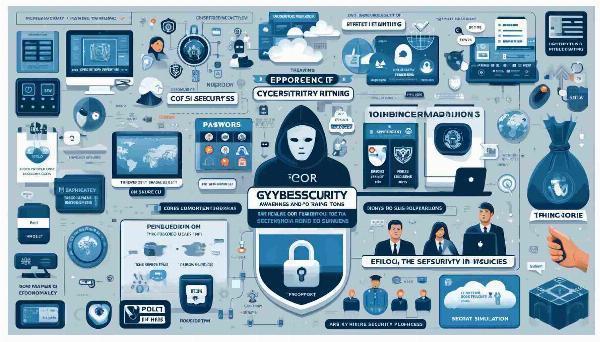Cybersecurity Awareness and Training Solutions

Strong 8k brings an ultra-HD IPTV experience to your living room and your pocket.
In an increasingly sophisticated era of cyber threats, the importance of cybersecurity awareness and training cannot be overstated. Effective cybersecurity training equips employees with the knowledge and tools to recognize and prevent potential cyber threats. This article explores the crucial elements of cybersecurity awareness and training solutions that organizations should consider to bolster their defences.
The Importance of Cybersecurity Training
Cybersecurity training is essential because human error remains one of the largest security vulnerabilities in any organization. It is crucial to educate employees about the risks and the actions they can take to mitigate them. Effective training can dramatically reduce the risk of breaches by helping employees identify phishing scams, manage passwords properly, and understand safe internet practices.
Core Components of Effective Training Solutions
Tailored Training Programs
One size does not fit all when it comes to cybersecurity training. Different roles within an organization face different risks and require specific knowledge and skills to mitigate those risks. Customizing training programs to the role and the individual’s level of cybersecurity knowledge can drastically improve effectiveness. For instance, IT staff might receive in-depth training on network security and incident response, while HR personnel are trained on safeguarding personal data and recognizing social engineering attacks.
Leveraging Behavioral Psychology
Understanding the psychological factors that influence behaviour can significantly enhance the design and delivery of training programs. Techniques from behavioural psychology, such as nudging and positive reinforcement, can be used to encourage secure habits. For example, small, frequent reminders about security best practices can be more effective than lengthy, infrequent training sessions. Similarly, gamification of training can increase engagement and retention of information, encouraging a competitive and fun learning environment.
Continuous Learning and Microlearning
Cyber threats evolve rapidly, and so should cybersecurity training. Incorporating continuous learning principles into the cybersecurity training framework helps keep security in mind for employees. Microlearning, which involves short, focused segments of learning designed to meet a specific learning outcome, can be particularly effective. These can be quick, daily or weekly security tips, quizzes, or brief videos highlighting a recent threat or a common security mistake.
Real-Time Feedback
Providing real-time employee feedback after training exercises, especially simulations like phishing tests, can reinforce learning and improve behavioural change. Immediate feedback helps individuals recognize what they did wrong and how they can avoid similar mistakes in the future. This practice helps solidify the learning and adjust the training modules according to the common vulnerabilities observed among the participants.
Advanced Reporting and Analytics
Organizations must invest in advanced reporting and analytics tools to continuously improve cybersecurity training efforts. These tools can track the effectiveness of training programs, identify areas where employees are struggling, and measure improvements over time. Analytics can provide insights into the most effective training methods and topics, enabling organizations to tailor their approach to maximize learning outcomes and ROI.
Culture of Security
Ultimately, any cybersecurity training program aims to foster a culture of security within the organization. This involves not just educating employees but also modelling good security behaviours at all levels of the organization. Leadership should actively participate in cybersecurity training and demonstrate a commitment to security. Regular communications from leaders about the importance of security can reinforce its value and encourage all employees to take their roles in security seriously.
Integrating AI and Automation
Looking forward, integrating AI and automation into cybersecurity training can provide personalized learning experiences and more efficient management of training programs. AI can help identify individual learning patterns and customise the training content accordingly. Moreover, automated systems can schedule training, send reminders, and update employees about new threats regularly, ensuring continuous education and compliance.
Popular Cybersecurity Training Solutions
Several cybersecurity training solutions stand out due to their comprehensiveness, ease of use, and effectiveness:
KnowBe4: Offers a platform for security awareness training and simulated phishing attacks, helping organizations manage the ongoing problem of social engineering.
Proofpoint Security Awareness Training: Provides integrated secure solutions that include risk assessment, a personalized approach to training, and detailed reporting on employee vulnerability.
NINJIO: Uses engaging, story-based learning to teach employees about cybersecurity, focusing on real-world security incidents to highlight potential threats.
Integration with Wider Security Policies
Cybersecurity training should be part of a broader information security policy. This integration ensures that training is not just about checking a box but is a critical component of an organization's security strategy. Training outcomes should inform security policies, and vice versa, to ensure both are aligned and effective.
Conclusion
Cybersecurity awareness and training is essential for protecting an organization from cyber threats. By fostering a culture of security awareness, organizations can significantly enhance their overall security posture. Effective training reduces risk, not just by preventing breaches but also by preparing employees to respond swiftly and effectively in case an incident does occur.
Note: IndiBlogHub features both user-submitted and editorial content. We do not verify third-party contributions. Read our Disclaimer and Privacy Policyfor details.


